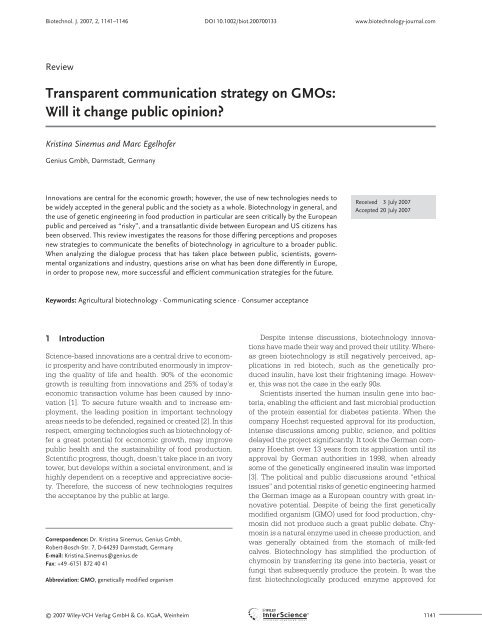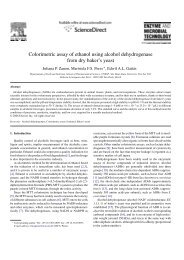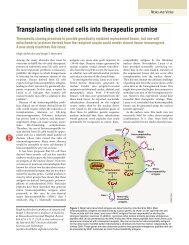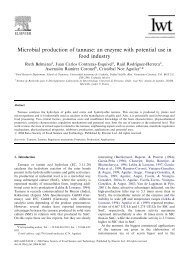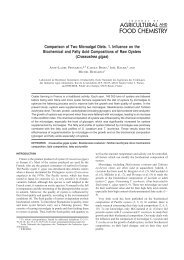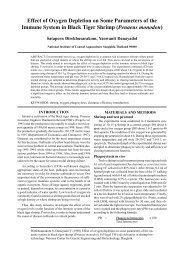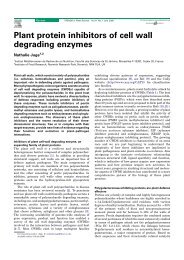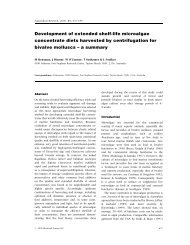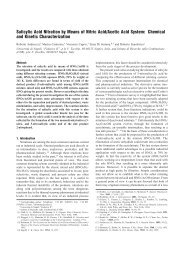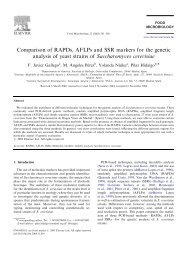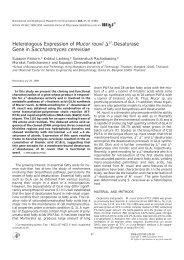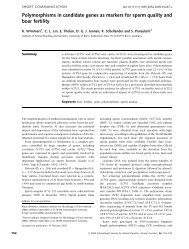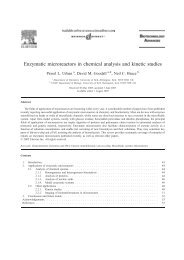Transparent communication strategy on GMOs: Will it change public opinion?
Transparent communication strategy on GMOs: Will it change public opinion?
Transparent communication strategy on GMOs: Will it change public opinion?
Create successful ePaper yourself
Turn your PDF publications into a flip-book with our unique Google optimized e-Paper software.
Biotechnol. J. 2007, 2, 1141–1146 DOI 10.1002/biot.200700133 www.biotechnology-journal.com<br />
Review<br />
<str<strong>on</strong>g>Transparent</str<strong>on</strong>g> <str<strong>on</strong>g>communicati<strong>on</strong></str<strong>on</strong>g> <str<strong>on</strong>g>strategy</str<strong>on</strong>g> <strong>on</strong> <strong>GMOs</strong>:<br />
<strong>Will</strong> <strong>it</strong> <strong>change</strong> <strong>public</strong> opini<strong>on</strong>?<br />
Kristina Sinemus and Marc Egelhofer<br />
Genius Gmbh, Darmstadt, Germany<br />
Innovati<strong>on</strong>s are central for the ec<strong>on</strong>omic growth; however, the use of new technologies needs to<br />
be widely accepted in the general <strong>public</strong> and the society as a whole. Biotechnology in general, and<br />
the use of genetic engineering in food producti<strong>on</strong> in particular are seen cr<strong>it</strong>ically by the European<br />
<strong>public</strong> and perceived as “risky”, and a transatlantic divide between European and US c<strong>it</strong>izens has<br />
been observed. This review investigates the reas<strong>on</strong>s for those differing percepti<strong>on</strong>s and proposes<br />
new strategies to communicate the benef<strong>it</strong>s of biotechnology in agriculture to a broader <strong>public</strong>.<br />
When analyzing the dialogue process that has taken place between <strong>public</strong>, scientists, governmental<br />
organizati<strong>on</strong>s and industry, questi<strong>on</strong>s arise <strong>on</strong> what has been d<strong>on</strong>e differently in Europe,<br />
in order to propose new, more successful and efficient <str<strong>on</strong>g>communicati<strong>on</strong></str<strong>on</strong>g> strategies for the future.<br />
Keywords: Agricultural biotechnology · Communicating science · C<strong>on</strong>sumer acceptance<br />
1 Introducti<strong>on</strong><br />
Science-based innovati<strong>on</strong>s are a central drive to ec<strong>on</strong>omic<br />
prosper<strong>it</strong>y and have c<strong>on</strong>tributed enormously in improving<br />
the qual<strong>it</strong>y of life and health. 90% of the ec<strong>on</strong>omic<br />
growth is resulting from innovati<strong>on</strong>s and 25% of today’s<br />
ec<strong>on</strong>omic transacti<strong>on</strong> volume has been caused by innovati<strong>on</strong><br />
[1]. To secure future wealth and to increase employment,<br />
the leading pos<strong>it</strong>i<strong>on</strong> in important technology<br />
areas needs to be defended, regained or created [2]. In this<br />
respect, emerging technologies such as biotechnology offer<br />
a great potential for ec<strong>on</strong>omic growth, may improve<br />
<strong>public</strong> health and the sustainabil<strong>it</strong>y of food producti<strong>on</strong>.<br />
Scientific progress, though, doesn’t take place in an ivory<br />
tower, but develops w<strong>it</strong>hin a societal envir<strong>on</strong>ment, and is<br />
highly dependent <strong>on</strong> a receptive and appreciative society.<br />
Therefore, the success of new technologies requires<br />
the acceptance by the <strong>public</strong> at large.<br />
Corresp<strong>on</strong>dence: Dr. Kristina Sinemus, Genius Gmbh,<br />
Robert-Bosch-Str. 7, D-64293 Darmstadt, Germany<br />
E-mail: Kristina.Sinemus@genius.de<br />
Fax: +49 -6151 872 40 41<br />
Abbreviati<strong>on</strong>: GMO, genetically modified organism<br />
Received 3 July 2007<br />
Accepted 20 July 2007<br />
Desp<strong>it</strong>e intense discussi<strong>on</strong>s, biotechnology innovati<strong>on</strong>s<br />
have made their way and proved their util<strong>it</strong>y. Whereas<br />
green biotechnology is still negatively perceived, applicati<strong>on</strong>s<br />
in red biotech, such as the genetically produced<br />
insulin, have lost their frightening image. However,<br />
this was not the case in the early 90s.<br />
Scientists inserted the human insulin gene into bacteria,<br />
enabling the efficient and fast microbial producti<strong>on</strong><br />
of the protein essential for diabetes patients. When the<br />
company Hoechst requested approval for <strong>it</strong>s producti<strong>on</strong>,<br />
intense discussi<strong>on</strong>s am<strong>on</strong>g <strong>public</strong>, science, and pol<strong>it</strong>ics<br />
delayed the project significantly. It took the German company<br />
Hoechst over 13 years from <strong>it</strong>s applicati<strong>on</strong> until <strong>it</strong>s<br />
approval by German author<strong>it</strong>ies in 1998, when already<br />
some of the genetically engineered insulin was imported<br />
[3]. The pol<strong>it</strong>ical and <strong>public</strong> discussi<strong>on</strong>s around “ethical<br />
issues” and potential risks of genetic engineering harmed<br />
the German image as a European country w<strong>it</strong>h great innovative<br />
potential. Desp<strong>it</strong>e of being the first genetically<br />
modified organism (GMO) used for food producti<strong>on</strong>, chymosin<br />
did not produce such a great <strong>public</strong> debate. Chymosin<br />
is a natural enzyme used in cheese producti<strong>on</strong>, and<br />
was generally obtained from the stomach of milk-fed<br />
calves. Biotechnology has simplified the producti<strong>on</strong> of<br />
chymosin by transferring <strong>it</strong>s gene into bacteria, yeast or<br />
fungi that subsequently produce the protein. It was the<br />
first biotechnologically produced enzyme approved for<br />
© 2007 Wiley-VCH Verlag GmbH & Co. KGaA, Weinheim 1141
Biotechnology<br />
Journal<br />
food use by the FDA in the early 90s and is now widely<br />
used in the cheese producti<strong>on</strong> [4].<br />
The higher acceptance of genetically modified foods<br />
and feeds in North America compared to Europe [5] is<br />
dem<strong>on</strong>strated by the fact, that two thirds of GM corn cultivati<strong>on</strong>s<br />
in this regi<strong>on</strong> are genetically modified plants,<br />
whereas in Europe, GM plants make a minor proporti<strong>on</strong><br />
<strong>on</strong>ly. The <strong>public</strong> needs to be placed in a pos<strong>it</strong>i<strong>on</strong> to make<br />
qualified decisi<strong>on</strong>s, and pol<strong>it</strong>icians must take the lead in<br />
the societal discourse and assume their resp<strong>on</strong>sibil<strong>it</strong>y.<br />
One milest<strong>on</strong>e towards acceptance is to reach a better<br />
level of <strong>public</strong> “trust and understanding”, however, for obtaining<br />
this goal <strong>it</strong> is necessary to provide a broad basis of<br />
transparency <strong>on</strong> all possible levels, including pol<strong>it</strong>ics, governments<br />
and industry.<br />
In this review, we will analyze the origin of the transatlantic<br />
divide and propose appropriate <str<strong>on</strong>g>communicati<strong>on</strong></str<strong>on</strong>g><br />
strategies to enhance the <strong>public</strong> understanding of the<br />
facts <strong>on</strong> genetic engineering and the dependency <strong>on</strong><br />
biotechnological innovati<strong>on</strong>s in Europe.<br />
2 More informati<strong>on</strong> = higher acceptance?<br />
It has been often assumed, that the low acceptance in Europe<br />
correlates w<strong>it</strong>h a low amount of knowledge <strong>on</strong><br />
biotechnology and genetic engineering, suggesting that<br />
educati<strong>on</strong> programs would <strong>change</strong> the <strong>public</strong>s’ percepti<strong>on</strong>.<br />
Therefore, past <str<strong>on</strong>g>communicati<strong>on</strong></str<strong>on</strong>g> programs were often<br />
c<strong>on</strong>ducted as an “educati<strong>on</strong>al approach”. However, recent<br />
experiences and studies c<strong>on</strong>tradict this hypothesis.<br />
In fact, <strong>it</strong> appears that factual knowledge of science has<br />
l<strong>it</strong>tle influence <strong>on</strong> the att<strong>it</strong>udes [6], and campaigns to educate<br />
an apparently ignorant <strong>public</strong> did not significantly<br />
<strong>change</strong> att<strong>it</strong>udes. Evidence also comes from a recent Eurobarometer<br />
survey [7] showing that a major<strong>it</strong>y is still worried<br />
about genetically modified products in food and<br />
drinks (Fig.1).<br />
Figure 1. When EU-c<strong>it</strong>izens were asked to what extent they are worried<br />
about genetically modified products in food or drinks, 63% answered<br />
“very worried” or “fairly worried” (Data taken from [7]).<br />
1142 © 2007 Wiley-VCH Verlag GmbH & Co. KGaA, Weinheim<br />
Biotechnol. J. 2007, 2, 1141–1146<br />
Using results from a 1999 Eurobarometer survey, and<br />
a parallel teleph<strong>on</strong>e survey in the US in 2000, a study [8]<br />
also explored the relati<strong>on</strong>ship between levels of knowledge,<br />
educati<strong>on</strong> and percepti<strong>on</strong> for biotechnology across<br />
a number of medical and agricultural applicati<strong>on</strong>s. This<br />
study found <strong>on</strong>ly a weak relati<strong>on</strong>ship am<strong>on</strong>g these factors,<br />
questi<strong>on</strong>ing the comm<strong>on</strong> assumpti<strong>on</strong>, that higher scientific<br />
l<strong>it</strong>eracy produces greater acceptance. The authors<br />
found, that the differences between EU and US reacti<strong>on</strong>s<br />
to biotechnology appear to be a result of different trust<br />
and especially trust gap patterns, rather than knowledge<br />
or educati<strong>on</strong>. Findings from Young et al. [9] c<strong>on</strong>firmed this<br />
by identifying European suspici<strong>on</strong> and distrust towards<br />
large multinati<strong>on</strong>al companies being reverse to the USA.<br />
But is there such a great difference between US and<br />
EU c<strong>it</strong>izens in approving genetically modified foods as often<br />
assumed? A study by a research group for the “Pew<br />
In<strong>it</strong>iative On Food and Biotechnology” c<strong>on</strong>cluded [10] that<br />
Americans, similar to Europeans, also hold mixed att<strong>it</strong>udes<br />
towards genetically modified foods and are generally<br />
uncertain about their safety. When asked in 2001, <strong>on</strong>ly<br />
29% of Americans thought GM foods are safe. Over the<br />
course of the study, however, the number of Americans<br />
w<strong>it</strong>h this believe slightly increased to 34% in 2006. These<br />
data were c<strong>on</strong>firmed in a different study, where the “unsure”<br />
resp<strong>on</strong>se was the most comm<strong>on</strong> answer resp<strong>on</strong>dents<br />
gave when asked for their opini<strong>on</strong> of plant-based<br />
GM food products [11]. Americans remain unaware and<br />
not very knowledgeable about GM foods. The major<strong>it</strong>y<br />
does not know that around 70% of the food ingredients are<br />
GM modified, and is unsure about this issue, but at least<br />
shows interest in the topic.<br />
This raises our hypothesis 1: uncrystallized opini<strong>on</strong>s<br />
remain open to manipulati<strong>on</strong>, however, there is also still<br />
an opportun<strong>it</strong>y to have a dialogue, offering a great opportun<strong>it</strong>y<br />
to communicate and inform <strong>on</strong> genetically engineered<br />
food. This can be generally undertaken by several<br />
means, including a science-driven or emoti<strong>on</strong>ally-driven<br />
approach, or a mix of both. A lot of effort has been undertaken<br />
to educate about the science behind many of these<br />
technologies, but w<strong>it</strong>h lim<strong>it</strong>ed success <strong>on</strong>ly. The <str<strong>on</strong>g>strategy</str<strong>on</strong>g><br />
overestimated the level of <strong>public</strong> understanding of basic<br />
science and the level of interest most laypeople have in<br />
scientific details that underlie emerging technologies. In<br />
c<strong>on</strong>trast, emoti<strong>on</strong>al-driven campaigns proved to be qu<strong>it</strong>e<br />
successful for many NGOs, especially in the European<br />
countries (Fig. 2).<br />
There is most likely no “standardized” perfect <str<strong>on</strong>g>strategy</str<strong>on</strong>g>,<br />
and, as we will discuss below, some subgroups in the<br />
<strong>public</strong> are more emoti<strong>on</strong>ally-driven and also cannot be approached<br />
by educati<strong>on</strong>al <str<strong>on</strong>g>communicati<strong>on</strong></str<strong>on</strong>g> strategies. Other<br />
less educati<strong>on</strong>al approaches might be the way forward.<br />
Cultural aspects are also important and need to be c<strong>on</strong>sidered,<br />
as they influence the way of <str<strong>on</strong>g>communicati<strong>on</strong></str<strong>on</strong>g> and<br />
the overall percepti<strong>on</strong> in the <strong>public</strong> <strong>on</strong> new technologies,<br />
such as agricultural biotechnology.
Biotechnol. J. 2007, 2, 1141–1146 www.biotechnology-journal.com<br />
Figure 2. Most anti-GMO campaigns are purely emoti<strong>on</strong>al and do not take<br />
an informative or educati<strong>on</strong>al approach. Greenpeace activists dress as<br />
mice protesting outside the Council of Ministers building in Brussels (image:<br />
Greenpeace).<br />
3 Cultural differences and the lack of trust<br />
The differences in the EU and US <strong>on</strong> <strong>public</strong> c<strong>on</strong>cerns and<br />
percepti<strong>on</strong>s towards modern biotechnology in general,<br />
and GM foods in particular, are not driven solely by c<strong>on</strong>cerns<br />
about the technology <strong>it</strong>self, but are also affected by<br />
cultural influences [12]. One example can be found by the<br />
fact that Europeans and Americans are generally differing<br />
in their the relati<strong>on</strong>ship w<strong>it</strong>h foods. The European food<br />
culture has a str<strong>on</strong>g emphasis <strong>on</strong> the origins of foods, and<br />
therefore many Europeans buy their fru<strong>it</strong>s and vegetables<br />
<strong>on</strong> local markets. This is much less the case in the US. Europeans<br />
also tend to be more aware of how their food is<br />
produced, whereas Americans place more fa<strong>it</strong>h in science<br />
and regulatory bodies, that are m<strong>on</strong><strong>it</strong>oring the food and<br />
feed chain. This was c<strong>on</strong>firmed by survey data [13], which<br />
showed that the overall awareness of GM food seemed to<br />
be greater for German participants than for Americans.<br />
These differences about food have been further enhanced<br />
by different att<strong>it</strong>udes towards author<strong>it</strong>ies and regulati<strong>on</strong>s.<br />
Br<strong>it</strong>ish and European handling of several food issues in<br />
the 80s including the BSE outbreak lead to a significant<br />
lack of c<strong>on</strong>fidence. In c<strong>on</strong>trast, Americans have a reas<strong>on</strong>ably<br />
str<strong>on</strong>g fa<strong>it</strong>h in federal food regulati<strong>on</strong> and science in<br />
general, which has not been affected by any past food<br />
crises.<br />
These culturally derived c<strong>on</strong>cerns play an important<br />
role in Europe, that make the <strong>public</strong> more sens<strong>it</strong>ive for<br />
risks relating to the food safety, whereas US c<strong>it</strong>izens d<strong>on</strong>’t<br />
pay too much attenti<strong>on</strong> to those issues. This is also making<br />
EU c<strong>it</strong>izens more receptive for often emoti<strong>on</strong>ally-driven,<br />
<strong>public</strong> relati<strong>on</strong>s campaigns from anti-GMO n<strong>on</strong>-governmental<br />
organizati<strong>on</strong>s, which gained much less attenti<strong>on</strong><br />
in the US. To overcome the <strong>public</strong>s’ negative recepti<strong>on</strong><br />
for agricultural biotech, we raise our sec<strong>on</strong>d<br />
hypothesis, that relevant actors, such as governmental<br />
inst<strong>it</strong>uti<strong>on</strong>s as well as industry, may need to focus <strong>on</strong> gaining<br />
sustainable trust in a proactive, open, transparent and<br />
h<strong>on</strong>est l<strong>on</strong>g-term <str<strong>on</strong>g>communicati<strong>on</strong></str<strong>on</strong>g> <str<strong>on</strong>g>strategy</str<strong>on</strong>g>.<br />
4 Risks versus benef<strong>it</strong>s<br />
The claim that Europeans are generally less innovati<strong>on</strong>oriented<br />
has been proven not to be correct. Many technologies,<br />
such as nanotechnology and pharmacogenetics<br />
are perceived more pos<strong>it</strong>ively than green biotech and are<br />
supported by the European Public. Even gene therapy –<br />
seen as risky – seems to outweigh the risks through the<br />
medical and pharmaceutical benef<strong>it</strong>s (Fig. 3).<br />
Surveys have dem<strong>on</strong>strated, that Europeans are c<strong>on</strong>cerned<br />
about the fragil<strong>it</strong>y of nature and about the impact<br />
of human acti<strong>on</strong>s and technology up<strong>on</strong> nature [6]. Unless<br />
new crops and products are perceived as providing major<br />
c<strong>on</strong>sumer benef<strong>it</strong>s, the c<strong>on</strong>troversies may c<strong>on</strong>tinue. Biomedical<br />
applicati<strong>on</strong>s underline the importance of benef<strong>it</strong>s<br />
in the <strong>public</strong>’s resp<strong>on</strong>se to biotechnologies and suggest<br />
that the <strong>public</strong> adopts a more util<strong>it</strong>arian approach than<br />
many pol<strong>it</strong>icians believe. Att<strong>it</strong>ude research found, that<br />
risk percepti<strong>on</strong> is not the <strong>on</strong>ly factor for the acceptance,<br />
what also plays a role is the percepti<strong>on</strong> of potential benef<strong>it</strong>s<br />
[12]. A major<strong>it</strong>y of people in Europe see risks related to<br />
GM crops, and reject <strong>it</strong> due to an absence of benef<strong>it</strong>s. So,<br />
c<strong>on</strong>sumer c<strong>on</strong>cerns are not whether the risk is low compared<br />
w<strong>it</strong>h other activ<strong>it</strong>ies, rather, the c<strong>on</strong>cerns are what<br />
the <strong>public</strong> gets in ex<strong>change</strong> for accepting those risks.<br />
Therefore, proactive <str<strong>on</strong>g>communicati<strong>on</strong></str<strong>on</strong>g> has to emphasize<br />
<strong>on</strong> the benef<strong>it</strong>s, rather than “simply” defending certain<br />
risks as being low. However, <str<strong>on</strong>g>communicati<strong>on</strong></str<strong>on</strong>g> seems<br />
to be c<strong>on</strong>sistent w<strong>it</strong>h the currently established risk assessments<br />
of <strong>GMOs</strong>, which also focuses <strong>on</strong> the risks, underestimating<br />
the benef<strong>it</strong>s [14].<br />
Scientists tend to misjudge the <strong>public</strong> to be irrati<strong>on</strong>al<br />
when <strong>it</strong> comes to making decisi<strong>on</strong>s about biotechnology.<br />
This believe is dangerous, as <strong>it</strong> may lead to the c<strong>on</strong>clu-<br />
Figure 3. EU c<strong>it</strong>izens find all new technologies morally acceptable that<br />
have e<strong>it</strong>her no perceived risks or risks that are outweigh by their benef<strong>it</strong>s<br />
[7].<br />
© 2007 Wiley-VCH Verlag GmbH & Co. KGaA, Weinheim 1143
Biotechnology<br />
Journal<br />
si<strong>on</strong>, that, since the <strong>public</strong> is irrati<strong>on</strong>al, efforts to provide<br />
informati<strong>on</strong> and educati<strong>on</strong> are a waste of time and m<strong>on</strong>ey,<br />
or that the <strong>public</strong> cannot make “appropriate” decisi<strong>on</strong>s<br />
about biotechnology. The <strong>public</strong> has a much wider scope<br />
and is able to evaluate risks versus benef<strong>it</strong>s. This raises or<br />
hypothesis 3: It can be c<strong>on</strong>cluded, that Europeans are<br />
not less innovati<strong>on</strong>-friendly, however, risks are not communicated<br />
appropriately and EU-c<strong>it</strong>izens react oversens<strong>it</strong>ively<br />
to them.<br />
5 Target-oriented <str<strong>on</strong>g>communicati<strong>on</strong></str<strong>on</strong>g>s<br />
As described above, some of the main reas<strong>on</strong>s for the low<br />
acceptance of GM foods in Europe are to be found in a<br />
trust gap into inst<strong>it</strong>uti<strong>on</strong>s and larger multinati<strong>on</strong>al companies,<br />
as well as in a low level of awareness <strong>on</strong> the perceived<br />
benef<strong>it</strong>s of this new technology. In this respect,<br />
pol<strong>it</strong>icians play a significant role in supporting pessimistic<br />
and emoti<strong>on</strong>al-driven debates instead of taking<br />
an informative and educative approach, thereby fulfilling<br />
the social c<strong>on</strong>science they possess.<br />
Therefore, new <str<strong>on</strong>g>communicati<strong>on</strong></str<strong>on</strong>g> strategies may be developed,<br />
which do address those issues. Communicati<strong>on</strong><br />
experience has shown that the following factors are of significant<br />
importance:<br />
– Credibil<strong>it</strong>y<br />
– Translati<strong>on</strong> of complex technical informati<strong>on</strong> into easily<br />
understandable language<br />
– Attractive, target-oriented “c<strong>on</strong>d<strong>it</strong>i<strong>on</strong>ing” of the informati<strong>on</strong><br />
w<strong>it</strong>h opti<strong>on</strong>s for interactive feedback<br />
– Value-free reporting – the <strong>public</strong> is capable to assess<br />
informati<strong>on</strong><br />
Choosing and employing the most appropriate <str<strong>on</strong>g>communicati<strong>on</strong></str<strong>on</strong>g><br />
tools for a specific target group requires a clear picture<br />
of “the <strong>public</strong>”. It is, however, a rather complex ent<strong>it</strong>y,<br />
influenced by various factors, such as differing values,<br />
wishes, fears, social rankings, the cultural envir<strong>on</strong>ment,<br />
ethics, buying behaviors and more. In other words: the<br />
broad “<strong>public</strong>” as such doesn’t exist, and can be divided<br />
into specific subgroups. This is an important <str<strong>on</strong>g>communicati<strong>on</strong></str<strong>on</strong>g><br />
issue, as some c<strong>on</strong>sumers actively seek informati<strong>on</strong><br />
and make trade-off between risks and benef<strong>it</strong>s, and<br />
others inher<strong>it</strong> att<strong>it</strong>udes or opini<strong>on</strong>s passively from the envir<strong>on</strong>ment<br />
[15].<br />
In a specific cultural envir<strong>on</strong>ment certain fundamental<br />
values, percepti<strong>on</strong>s, preferences and behaviors are<br />
adopted, transferred to the next generati<strong>on</strong>, and do evolve<br />
over time. Because of the complex<strong>it</strong>y and timely alterati<strong>on</strong><br />
of these factors, market research developed various approaches<br />
for a clearer segmentati<strong>on</strong> of c<strong>on</strong>sumers and<br />
several models based <strong>on</strong> statistical informati<strong>on</strong> do exist.<br />
Starting from the sociological described target groups,<br />
psychological and also recently neurobiological based differentiati<strong>on</strong>s<br />
are being made, leading to target group ty-<br />
1144 © 2007 Wiley-VCH Verlag GmbH & Co. KGaA, Weinheim<br />
Biotechnol. J. 2007, 2, 1141–1146<br />
pologies [16]. A market-research based and simplified<br />
classificati<strong>on</strong> is offered by Herbst [17], a scheme that discriminates<br />
the “<strong>public</strong>” into three types:<br />
Type 1. Martin, the avoider<br />
Martin, the avoider is characterized by not pro-actively<br />
searching for informati<strong>on</strong> and w<strong>it</strong>hout undertaking cr<strong>it</strong>ical<br />
analyses. He avoids theoretical c<strong>on</strong>troversies. Typical<br />
are pessimistic thoughts and views, such as „What can<br />
we generally eat safely nowadays?”<br />
Type 2. Svenja, the passive<br />
Hed<strong>on</strong>istic views and att<strong>it</strong>udes are characteristic for<br />
Svenja, the passive. Being 22, student and single, she<br />
wants to subsist healthy. She looks at pictures and has<br />
str<strong>on</strong>g emoti<strong>on</strong>al reacti<strong>on</strong>s. She is – similar to Martin – not<br />
actively seeking informati<strong>on</strong> and is not greatly willing or<br />
able to estimate risks <strong>on</strong> her own.<br />
Type 3. Dörte, the active
Biotechnol. J. 2007, 2, 1141–1146 www.biotechnology-journal.com<br />
Competent in questi<strong>on</strong>s <strong>on</strong> foods, she is typically 32 years,<br />
mother of 2 children and is comm<strong>it</strong>ted to feed the family<br />
the best way possible. She is well informed and is proactively<br />
seeking for informati<strong>on</strong>. She is interested, active<br />
and cr<strong>it</strong>ical, and wants to assess risks independently.<br />
The different behaviors of these stereotypes lead to a<br />
distinct acquis<strong>it</strong>i<strong>on</strong> of informati<strong>on</strong> w<strong>it</strong>h varying depths of<br />
complex<strong>it</strong>y and to a use of different media channels. This<br />
has a str<strong>on</strong>g impact when developing a <str<strong>on</strong>g>communicati<strong>on</strong></str<strong>on</strong>g><br />
<str<strong>on</strong>g>strategy</str<strong>on</strong>g> towards the “general <strong>public</strong>”. For each of the<br />
three stereotypes, specific media channels need to be employed.<br />
The Dörte-type can be accessed by pull media,<br />
such as webs<strong>it</strong>es, and intensive c<strong>on</strong>sultati<strong>on</strong> (dialogue).<br />
On GM foods and feeds, internet s<strong>it</strong>es such as gmo-compass.org<br />
are appropriate and proven <str<strong>on</strong>g>communicati<strong>on</strong></str<strong>on</strong>g><br />
channels. The internet also offers a broad spectrum of add<strong>it</strong>i<strong>on</strong>al<br />
opti<strong>on</strong>s, including weblogs, podcasts or wikis, as<br />
su<strong>it</strong>able formats for this “<str<strong>on</strong>g>communicati<strong>on</strong></str<strong>on</strong>g> stereotype”.<br />
By far more difficult targets are Martin and Svenja, as<br />
they do have a more passive media behavior and feel more<br />
attracted by push media and more imagery-heavy <str<strong>on</strong>g>communicati<strong>on</strong></str<strong>on</strong>g><br />
tools, such as TV or other advertising campaigns.<br />
We c<strong>on</strong>clude from that, that more emoti<strong>on</strong>allydriven<br />
outreach programs, such as “science events”<br />
might be more appropriate than pull media. This needs to<br />
be taken into account, if successful <str<strong>on</strong>g>communicati<strong>on</strong></str<strong>on</strong>g><br />
strategies aim at targeting Martin and Svenja (see Fig.4 ).<br />
6 C<strong>on</strong>clusi<strong>on</strong>s<br />
Communicati<strong>on</strong>s are an integral and cr<strong>it</strong>ical step in innovati<strong>on</strong>.<br />
New genetically modified plants do not possess<br />
any value, if they are rejected by the major<strong>it</strong>y of the <strong>public</strong>.<br />
Past <str<strong>on</strong>g>communicati<strong>on</strong></str<strong>on</strong>g> activ<strong>it</strong>ies were often perceived<br />
as a <strong>on</strong>e-way <str<strong>on</strong>g>communicati<strong>on</strong></str<strong>on</strong>g> by which scientists tell<br />
“their truth” in simple educati<strong>on</strong>al approaches. However,<br />
this has been proved to be not appropriate and unsuccessful<br />
to inform and “c<strong>on</strong>vince” the general <strong>public</strong>. As<br />
described here, several factors need to be taken in c<strong>on</strong>siderati<strong>on</strong>,<br />
when applying new <str<strong>on</strong>g>communicati<strong>on</strong></str<strong>on</strong>g>s strategies,<br />
which include:<br />
Figure 4. Successful <str<strong>on</strong>g>communicati<strong>on</strong></str<strong>on</strong>g><br />
strategies need to<br />
c<strong>on</strong>sider the various subgroups<br />
of “the <strong>public</strong>” and<br />
should be based <strong>on</strong> the four<br />
characteristics of credibil<strong>it</strong>y,<br />
trust, plainness and tailored.<br />
6.1 Increased engagement of industry and governmental<br />
organizati<strong>on</strong>s <strong>on</strong> issues regarding GM foods and feeds<br />
Informati<strong>on</strong> <strong>on</strong> biotechnology in the media are rarely<br />
proactive, rather, they usually appear in resp<strong>on</strong>se to highly<br />
visible reports. Increased trust should be <strong>on</strong>e key objective<br />
for <str<strong>on</strong>g>communicati<strong>on</strong></str<strong>on</strong>g>s by governmental and industrial<br />
<str<strong>on</strong>g>communicati<strong>on</strong></str<strong>on</strong>g> partners.<br />
6.2 Focus <strong>on</strong> the benef<strong>it</strong>s, rather than defending<br />
“acceptable” risks<br />
Key to acceptance is to take <strong>public</strong> c<strong>on</strong>cerns seriously, but<br />
at the same time communicating the benef<strong>it</strong>s of the new<br />
technologies for the c<strong>on</strong>sumers themselves. It is therefore<br />
important to foster a “c<strong>on</strong>sumer benef<strong>it</strong>s <str<strong>on</strong>g>communicati<strong>on</strong></str<strong>on</strong>g><br />
<str<strong>on</strong>g>strategy</str<strong>on</strong>g>”, rather than a “classical” risk <str<strong>on</strong>g>communicati<strong>on</strong></str<strong>on</strong>g><br />
approach.<br />
6.3 Better defin<strong>it</strong>i<strong>on</strong> of the target audience for a more<br />
target-oriented <str<strong>on</strong>g>communicati<strong>on</strong></str<strong>on</strong>g> approach<br />
The general “<strong>public</strong>” is a complex ent<strong>it</strong>y of sub-populati<strong>on</strong>s,<br />
w<strong>it</strong>h each of them resp<strong>on</strong>ding to different formats<br />
and styles of <str<strong>on</strong>g>communicati<strong>on</strong></str<strong>on</strong>g>, and w<strong>it</strong>h varying access of<br />
informati<strong>on</strong>. Therefore, part of the <str<strong>on</strong>g>communicati<strong>on</strong></str<strong>on</strong>g> <str<strong>on</strong>g>strategy</str<strong>on</strong>g><br />
is to cap<strong>it</strong>alize the knowledge <strong>on</strong> the audiences’ preferences<br />
and to use “tailored” <str<strong>on</strong>g>communicati<strong>on</strong></str<strong>on</strong>g> tools.<br />
Scientists and biotechnology developers have often<br />
assumed, that the <strong>public</strong> would embrace the new technology<br />
as “obviously pos<strong>it</strong>ive” and dismissed <strong>public</strong> c<strong>on</strong>cerns<br />
as irrelevant or even “incompetent”. However, <strong>it</strong> is<br />
important to seriously c<strong>on</strong>sider the <strong>public</strong> needs and address<br />
their c<strong>on</strong>cerns. It is therefore important, that industry<br />
and governmental bodies proactively seek trust and<br />
c<strong>on</strong>fidence from the <strong>public</strong>. Green biotech offers a<br />
tremendous amount of potential benef<strong>it</strong>s, including a better<br />
sustainabil<strong>it</strong>y of modern food producti<strong>on</strong>. New GM<br />
plant tra<strong>it</strong>s and sustainable technologies might increase<br />
the efficiency of agriculture, for example w<strong>it</strong>h a decreased<br />
use of herbicides or chemicals, thereby lowering CO2<br />
emissi<strong>on</strong>s. This provides communicators <strong>on</strong> all levels a<br />
sec<strong>on</strong>d chance to lift this technology towards a greater<br />
acceptance globally. If important and useful innovati<strong>on</strong>s<br />
are not adopted in practice, societies might experience<br />
severe disadvantages.<br />
© 2007 Wiley-VCH Verlag GmbH & Co. KGaA, Weinheim 1145
Biotechnology<br />
Journal<br />
7 References<br />
[1] Siemens Science Board, Financial Times Deutschland 10/2004<br />
[2] Bost<strong>on</strong> C<strong>on</strong>sulting Group, Innovati<strong>on</strong>sstandort Deutschland – quo<br />
vadis?. http://www.bcg.com/<strong>public</strong>ati<strong>on</strong>s/files/BCG_Studie_Innovati<strong>on</strong>sstandort_Deutschland_–_quo_vadis_03Jan07.pdf.<br />
[3] Peerenboom, E., Hoechst producti<strong>on</strong> of recombinant human insulin<br />
finally begins after 14-year battle. Nat. Biotech. 1998, 16, 409.<br />
[4] Johns<strong>on</strong>, M. E., Lucey, J. A., Major technological advances and<br />
trends in cheese. J. Dairy Sci. 2006, 89, 1174–1178.<br />
[5] Gaskell, G., Bauer, M. W., Durant, J., Allum, N. C., Worlds Apart?<br />
The recepti<strong>on</strong> of genetically modified foods in Europe and the US.<br />
Science 1999, 285, 384–387.<br />
[6] Gaskell, G., Allum, N., Stares, S., Europeans and Biotechnology in<br />
2002, Eurobarometer 58.0, A report to the EC Directorate General<br />
for Research from the project ‘Life Sciences in European Society<br />
QLG7-CT-1999-00286’, 2003 http://ec.europa.eu/<strong>public</strong>_opini<strong>on</strong>/<br />
archives/ebs/ebs_177_en.pdf<br />
[7] Gaskell, G., Allansdottir, A., Allum, N., Corchero, C. et al., Europeans<br />
and Biotechnology in 2005: Patterns and Trends. Eurobarometer<br />
64.3 – A report to the European Commissi<strong>on</strong>’s Directorate-General<br />
for Research 2006. www.ec.europa.eu/research/<br />
press/2006/pdf/pr/906_eb_64_3_final_report-mag2006_en.pdf<br />
[8] Priest, S. H., B<strong>on</strong>fadelli, H., Rusanen, M., The “trust gap” hypothesis:<br />
predicting support for biotechnology across nati<strong>on</strong>al culture as<br />
a functi<strong>on</strong> of trust in actors. Risk Analysis 2003, 23, 751–766.<br />
[9] Young, J., Cormick, C., Public c<strong>on</strong>cerns towards GM food are not<br />
driven solely by c<strong>on</strong>cerns about the technology, but more str<strong>on</strong>gly<br />
by cultural differences. PCST C<strong>on</strong>ference 2004. Barcel<strong>on</strong>a, Spain.<br />
[10] The Pew In<strong>it</strong>iative <strong>on</strong> Food and Biotechnology, “Public sentiment<br />
about genetically modified food”, Memorandum November 2006,<br />
USA; http//pewagbiotech.org<br />
[11] Hallman, W. K., Hebden, W. C., Cu<strong>it</strong>e, C. L., Aquino, H. L., Lang, J.<br />
T., Americans and GM food: knowledge, opini<strong>on</strong> and interesting in<br />
2004. Food Policy Inst<strong>it</strong>ute, Cook College, Rutgers – the State Univers<strong>it</strong>y<br />
of New Jersey, Publicati<strong>on</strong> No. RR-1104-007, New Jersey<br />
2004.<br />
[12] Gaskell, G., Allum, N., Wagner, W., Kr<strong>on</strong>berger, N. et al., GM foods<br />
and the mispercepti<strong>on</strong> of risk percepti<strong>on</strong>. Risk Anal. 2004, 24,<br />
185–194.<br />
[13] Aquino, H. L., Hallman, W. K., Differences in the percepti<strong>on</strong>s of<br />
agricultural biotechnology: a comparis<strong>on</strong> study between Germany<br />
and the Un<strong>it</strong>ed States. PCST C<strong>on</strong>ference 2004, Barcel<strong>on</strong>a, Spain;<br />
www.pcst2004.org/epp/pdf/pcst_book.pdf<br />
1146 © 2007 Wiley-VCH Verlag GmbH & Co. KGaA, Weinheim<br />
Biotechnol. J. 2007, 2, 1141–1146<br />
Dr. Kristina Sinemus studied Biology,<br />
German and Pedagogic at the univers<strong>it</strong>ies<br />
of Münster and Kassel. 1995 she<br />
obtained her ph. D. <strong>on</strong> “Biological risks<br />
in field release of transgene plants“at<br />
the Inst<strong>it</strong>ute for Biochemistry at the<br />
Technical Univers<strong>it</strong>y of Darmstadt. From<br />
1991-1995 she was Scientific collaborator<br />
at the Interdisciplinary Engineering<br />
Research centre (Zentrum für interdisziplinäre<br />
Technikforschung - ZIT) at the Technical Univers<strong>it</strong>y of<br />
Darmstadt, project: “Ethical cr<strong>it</strong>eria bearing up<strong>on</strong> decisi<strong>on</strong>s taken in<br />
the field of biotechnology“. From 1995-1998 Dr. Sinemus led the Public<br />
Relati<strong>on</strong>s Working Group at the Inst<strong>it</strong>ute of Biochemistry at the<br />
Technical Univers<strong>it</strong>y in Darmstadt, which became „CLS - Communicati<strong>on</strong><br />
in Life Sciences“ in 1997 and took part in the German-wide BioRegio-compet<strong>it</strong>i<strong>on</strong>.<br />
Since1997 she organizes the “Gesprächskreis Grüne<br />
Gentechnik”, a round table of pol<strong>it</strong>ical work in the food chain. She is<br />
CEO of Genius Ltd. (Biotech-scientific c<strong>on</strong>sulting and <str<strong>on</strong>g>communicati<strong>on</strong></str<strong>on</strong>g>),<br />
which she founded 1998. Dr. Sinemus holds various part-time<br />
lectureships <strong>on</strong> Bioethics and Genetic Engineering and is very active in<br />
the field of biosafety research where she manages different European<br />
projects.<br />
[14] Report of the ACRE sub-group <strong>on</strong> wider issues raised by the farmscale<br />
evaluati<strong>on</strong>s of herbicide tolerant GM crops. “Managing the<br />
footprint of agriculture: towards a comparative assessment of risks<br />
and benef<strong>it</strong>s for novel agricultural systems”, 2007, UK; www.<br />
defra.gov.uk/envir<strong>on</strong>ment/acre/fsewiderissues/pdf/acre-wi-final.pdf<br />
[15] Wansink, B., Kim, Juny<strong>on</strong>g, The marketing battle over genetically<br />
modified foods : c<strong>on</strong>sumer acceptance of biotechnology, American<br />
Behavioral Scientist 2001, 44, 1405–1417.<br />
[16] http://www.sinus-sociovisi<strong>on</strong>.de/2/2-3-1-1.htm<br />
[17] Herbst, D., „Praxishandbuch Unternehmenskommunikati<strong>on</strong>“, Cornelsen<br />
Verlag, Berlin, Germany 2003.


